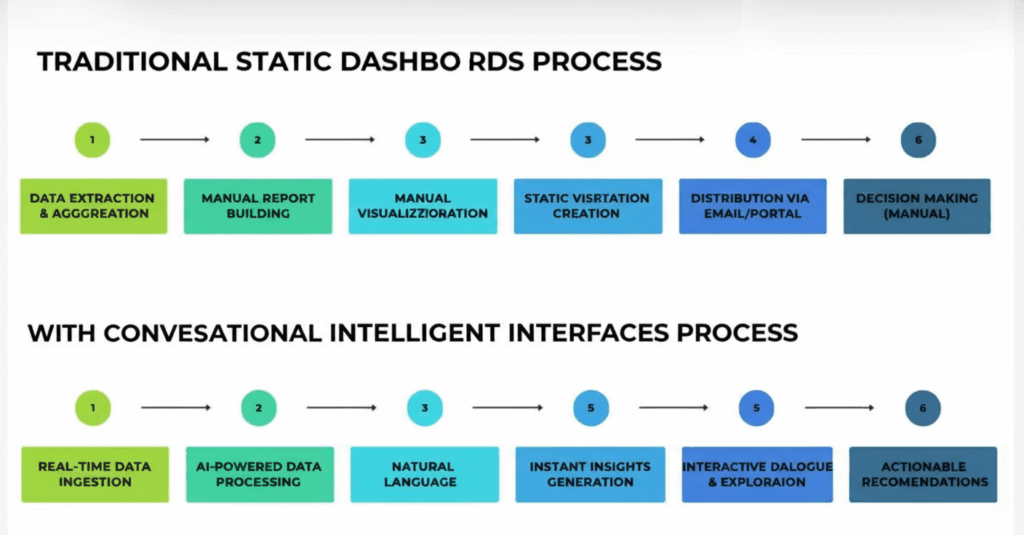Accelerate IT operations with AI-driven Automation
Automation in IT operations enable agility, resilience, and operational excellence, paving the way for organizations to adapt swiftly to changing environments, deliver superior services, and achieve sustainable success in today's dynamic digital landscape.
Driving Innovation with Next-gen Application Management
Next-generation application management fueled by AIOps is revolutionizing how organizations monitor performance, modernize applications, and manage the entire application lifecycle.
AI-powered Analytics: Transforming Data into Actionable Insights
AIOps and analytics foster a culture of continuous improvement by providing organizations with actionable intelligence to optimize workflows, enhance service quality, and align IT operations with business goals.
For decades, IT operations have revolved around rigid structures: static dashboards, drop-down menus, and ticket queues. These systems were efficient for their time – structured, predictable, and hierarchical. But the enterprise user has changed.
Today’s workforce expects consumer-grade digital experiences: fast, intuitive, and human. The same ease with which we ask Siri for directions or ChatGPT for summaries is now expected in how employees engage with enterprise IT. Yet, most IT Service Management (ITSM) tools still rely on forms, scripts, and workflows that require users to adapt to the system rather than the system adapting to them.

That’s where Qinfinite’s Conversational and Actionable Interface redefines the experience. It’s not a chatbot bolted onto a service portal. It’s an intelligent, context-aware, and action-capable interface that allows enterprise users to talk to systems, data, and automation tools and get work done all through natural language.
Imagine being able to:
- Talk to systems, documents, and automations as if you were speaking to a colleague
- Ask for real-time insights, root cause analyses, or SLA summaries
- Trigger configurations, patch jobs, or workflows with a simple prompt
- Generate or validate automation scripts and request approvals in-line
- Collaborate directly with domain-specific agents or subject-matter experts
And all this happens within your preferred communication channel whether that’s Microsoft Teams, Slack, WhatsApp, or even email.
Why It Matters: Beyond “Ticket Chatbots”
Most IT chatbots today stop at basic tasks like creating tickets, answering FAQs, or checking statuses. They are helpful, but they don’t fundamentally transform how IT interacts with the business.
Qinfinite’s conversational interface changes that paradigm. It acts as a conversational command center, combining the intelligence of Knowledge Graphs, Large Language Models (LLMs), and agentic automation frameworks to drive meaningful actions through dialogue.
This isn’t about automating ticket creation. It’s about enabling natural-language-to-action flows across the entire IT landscape. With Qinfinite, every conversation can:
- Retrieve insights from systems of record
- Invoke automations securely and contextually
- Learn from organizational knowledge and user behavior
- Operate under enterprise-grade policies, governance, and explainability
The result? IT operations that are faster, more responsive, and exponentially more intelligent.
What Can You Do With It?
The beauty of Qinfinite’s conversational interface lies in its role-based adaptability. It meets each user where they are, speaks their language, and delivers outcomes suited to their function.
IT Support
“Why are SAP jobs failing since last night?”
Qinfinite instantly scans logs, references known errors, checks system health, and presents a concise RCA summary with recommended remediation steps.
Business Operations
“Are all invoices processed for the APAC region today?”
The interface queries your BizOps or ERP engine, validates transactions, and returns a real-time view of SLAs and pending workflows in one conversational thread.
Automation Engineer
“Create a new patching automation for non-prod Linux VMs.”
Qinfinite leverages the Service Catalog to automatically generate a workflow, pre-populate metadata, and route it for approval, turning a conversation into a fully orchestrated automation.
New Team Member
“What does the Kafka connector for claims processing do?”
Instead of searching through documentation, the system queries internal codebases, wikis, and dependency graphs, delivering a concise, business-context summary.
SME or Architect
“Summarize recent failures related to integration job ABC123.”
Qinfinite analyzes historical incidents, correlates Slack threads, reviews log patterns, and extracts relevant insights, compressing hours of research into seconds.
LLM Integration: Any Model, Any Persona
At the heart of Qinfinite’s conversational layer lies model flexibility. Instead of locking enterprises into one AI vendor, it operates as an LLM-agnostic orchestration framework, integrating seamlessly with:
- Open-source models such as Llama, Falcon, or Mistral
- Proprietary Qinfinite-tuned LLMs optimized for ITSM and DevOps language
- Enterprise-grade models like GPT-4, Claude, or Gemini
- Domain-specific agents built for ITSM, BizOps, or Automation contexts
Enterprises can choose the best model per use case, while Qinfinite ensures governance, explainability, and safety across every interaction. This hybrid orchestration approach delivers the power of generative AI without compromising security or compliance.
Local Prompting, Global Impact
One of the most transformative aspects of Qinfinite’s interface is how simple conversations trigger enterprise-scale actions.
A single user prompt can:
- Create and validate a patch job
- Escalate an incident across multiple teams
- Update documentation in SharePoint or Confluence
- Configure a workflow in ServiceNow
- Or even prevent downtime by identifying anomalies in real time
Every interaction is context-aware, policy-compliant, and fully auditable. The interface doesn’t just understand intent, it executes it intelligently, bridging human language and machine action.
This isn’t just conversation. This is intelligent orchestration at scale where every dialogue becomes a driver of operational value.
| Feature | Value |
|---|---|
| Channel-Agnostic Access | Engage through Teams, Slack, Email, or WhatsApp |
| Knowledge Graph-Backed Context | Maps user roles, assets, systems, and dependencies for precise actions |
| Agentic Framework | Dynamically invokes applications, automations, or SME agents |
| Secure by Design | RBAC controls, audit trails, and explainability engine |
| LLM-Agnostic Architecture | Integrates any GenAI model per enterprise preference |
| Works with Existing Stack | No rip-and-replace – overlays Jira, ServiceNow, SharePoint, SAP, and more |
Real-World Impact: Intelligent Support Transformation
The transformative potential of Qinfinite’s conversational interface isn’t theoretical; it’s measurable.
A global industrial manufacturer adopted Qinfinite to unify IT support across SAP, Oracle, ServiceNow, and SharePoint. Within weeks of deployment, they achieved tangible results:

By allowing users to “talk to the system,” Qinfinite effectively turned complex IT ecosystems into intuitive, conversational experiences where the interface not only listens but acts intelligently.
The Future of IT Interaction
We’re witnessing the dawn of a new interface paradigm – one where natural language becomes the new command line. In the same way graphical user interfaces revolutionized computing in the 1980s, conversational interfaces are redefining enterprise productivity today.
By fusing large language models, automation frameworks, and contextual intelligence, Qinfinite transforming how IT responds, learns, and evolves.
The front door to ITSM is no longer a form or a portal. It’s a conversation and it’s open, intelligent, and ready to act.
Want to experience it?
Let us show you how a simple conversation can turn into clarity, control, and closed tickets instantly. Request for a demo or talk to our experts today!
FAQs
Qinfinite’s Conversational and Actionable Interface is an intelligent layer that allows enterprise users to interact with IT systems, data, and automation tools using natural language. It transforms the traditional, form-based IT experience into an intuitive dialogue where users can ask questions, request insights, or trigger actions directly through chat.
Backed by knowledge graph, agentic AI frameworks, and LLM integration, Qinfinite connects people, processes, and platforms in real time, turning every conversation into measurable action.
Most IT chatbots are limited to answering FAQs or creating support tickets. Qinfinite goes far beyond that. It functions as a conversational command center, capable of understanding context, analyzing system data, invoking automations, and delivering insights, not just responses.
Where traditional chatbots talk, Qinfinite acts. It leverages enterprise knowledge, automation frameworks, and governance models to ensure every interaction is intelligent, auditable, and outcome-driven.
Modern ITSM needs to be faster, smarter, and more human. As IT environments grow complex and teams become more distributed, static portals and ticket queues slow down resolution times.
Qinfinite’s conversational interface reimagines ITSM by:
Reducing manual effort through automation and guided responses.
Accelerating resolution via real-time insights and context-aware actions.
Improving user experience by making IT interaction as simple as messaging a colleague. In essence, it shifts ITSM from a reactive, form-based process to a proactive, conversational experience that enhances agility and service quality.
Qinfinite is channel-agnostic, meeting users where they already work. It supports:
Microsoft Teams
Slack
And can be extended to other enterprise collaboration tools via APIs. This ensures consistent, secure access to IT support and automation without requiring users to switch platforms or learn new tools.
With Qinfinite, users can do more than just ask questions; they can get work done. Depending on their role, users can:
Query systems: “Why are SAP jobs failing?” or “Show current SLA status for APAC.”
Trigger automations: “Run a non-prod patch workflow.”
Access knowledge: “Summarize Kafka connector documentation.”
Collaborate: “Escalate this issue to the integration team.”
Take corrective actions: “Restart the failed job on server A.”
